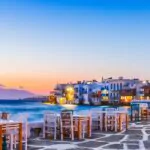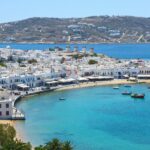Celebrating Greek Easter in Mykonos: A Journey of Tradition and Renewal
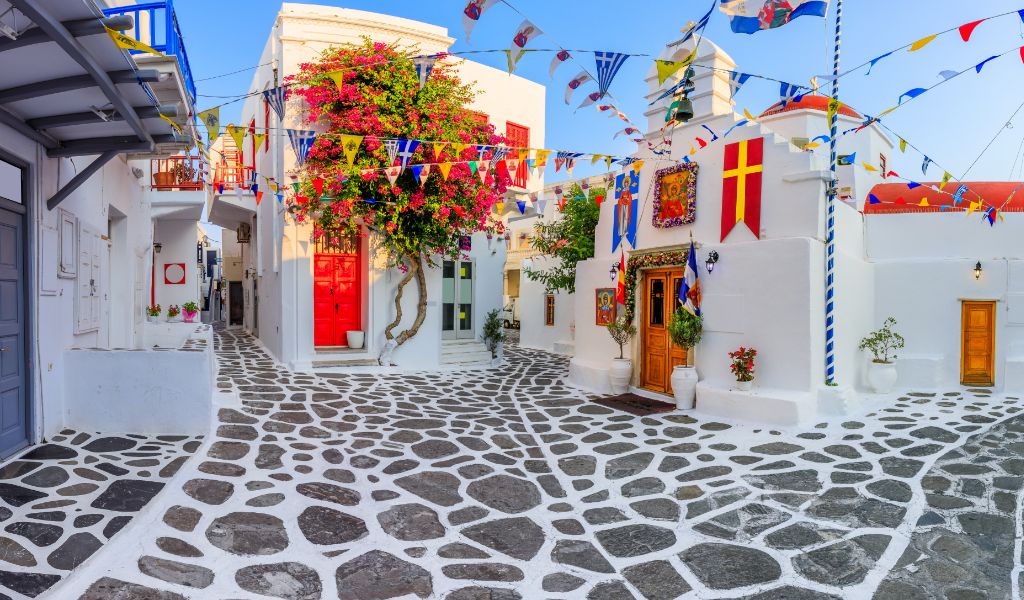
A Timeless Tradition in the Heart of the Aegean
Greek Easter in Mykonos stands as a beacon of Orthodox Christian faith, marking a period of vibrant celebration that radiates throughout Mykonos island Greece. This springtime festival is more than a religious observance; it’s an all-encompassing experience that engulfs the island in a wave of culture, community, and culinary delight. From the resonant peals of church bells to the communal gatherings in quaint squares, Mykonos transforms into a tableau of tradition and togetherness.
The Prelude to Summer: Easter in Mykonos
As the island bids farewell to the tranquility of winter, Greek Easter in Mykonos emerges with a unique blend of solemnity and festivity. It’s a period that captures the essence of Mykonos, a final chapter of serenity before the summer’s vibrancy takes hold. The celebration of life, renewal, and unity during Easter epitomizes the island’s rich heritage and the warm spirit of its inhabitants.
Top Recommended Hotels in Mykonos for Accommodation during Easter
A Cultural Immersion: The Essence of Greek Easter
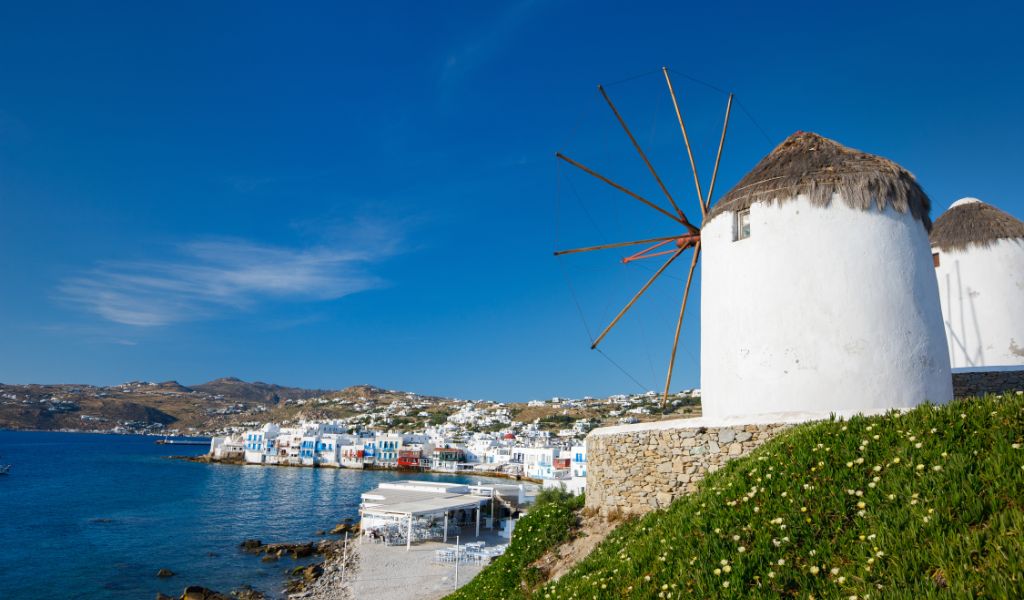
Traveling to Mykonos during Greek Easter offers an unparalleled opportunity to dive deep into the island’s cultural roots. Away from the bustling coastlines, the hillside villages of Mykonos offer a glimpse into the soul of the island. Here, the Easter celebration is an intimate affair, where the customs of generations are observed with reverence and joy.
Ano Mera: A Village Alive with Faith and Tradition
In the heart of Mykonos, the village of Ano Mera becomes a focal point for Easter celebrations. The Monastery of Panagia Tourliani, with its historical and spiritual significance, draws people from across the island. The procession of the Holy Icon, a profound symbol of faith and community, weaves through the villages, uniting everyone in a shared spiritual journey.
The Night of Resurrection: A Spectacle of Light and Joy
 Handmade Greek Easter Candles by Dandelion’s Light
Handmade Greek Easter Candles by Dandelion’s Light
As Easter Sunday approaches, anticipation builds to a crescendo. The ritual of the “lampada,” the exchange of ornately decorated candles, symbolizes the bonds of godparent to god-child, illuminating the night with a warm glow. At midnight, the air fills with hymns of resurrection, and the Holy light spreads among the faithful, a symbol of hope and renewal. Fireworks burst overhead, and the streets come alive with the joyous celebrations of the community.
Culinary Delights: Breaking the Fast with Flavor
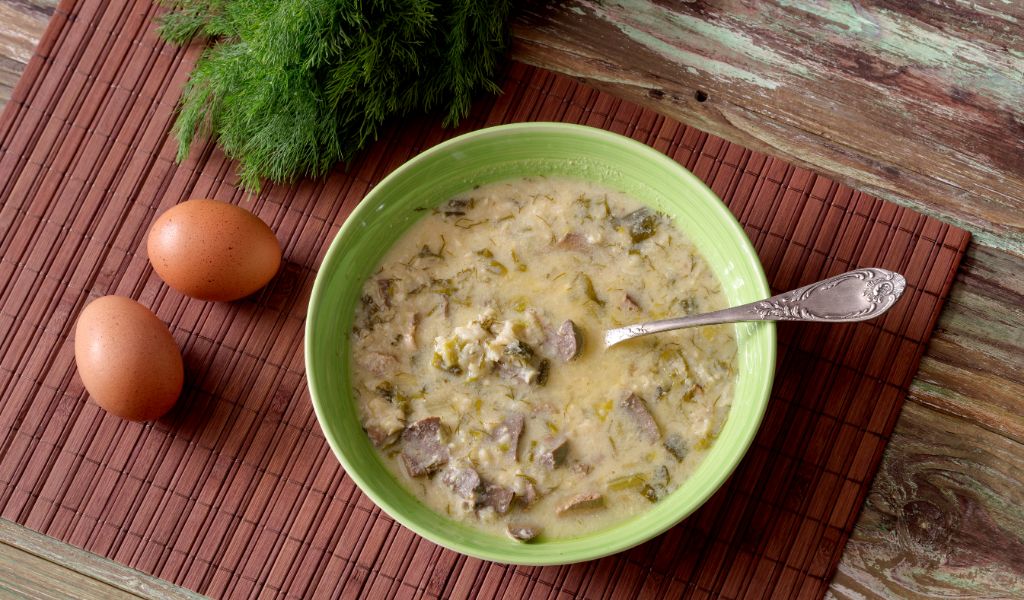
The culmination of Greek Easter in Mykonos is not just a spiritual renewal but also a gastronomic revelation. The traditional “magiritsa” soup, a zesty and savory dish, marks the end of the Lenten fast. Shared among family and friends, it embodies the essence of Easter in Mykonos: a celebration of life, tradition, and togetherness.
Easter Sunday in Mykonos: A Feast of Unity and Joy
The Heart of Greek Easter: Culinary Celebrations
Greek Easter in Mykonos is a day when the island’s rhythm slows, inviting everyone to gather around the table for a feast that is as much about community as it is about food. The essence of Greek culture—care, connection, and community—comes to life, particularly on Easter Sunday. This day is an open invitation to partake in a legacy of love that has been shared among generations, making it a focal point of Greek Easter in Mykonos.
The Quintessence of Greek Gastronomy
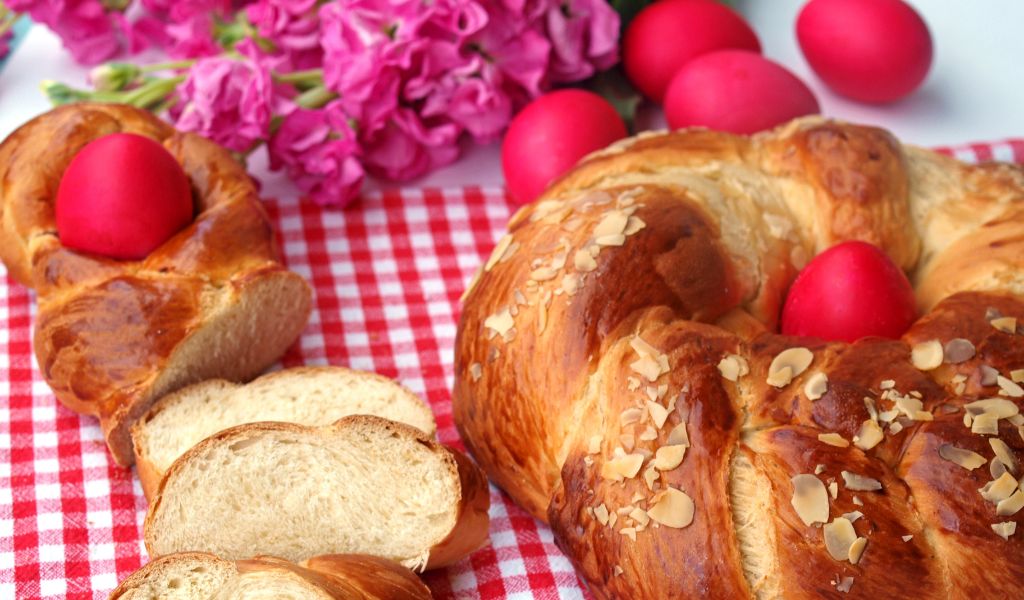
The highlight of the Easter feast is undoubtedly the lamb roasted on the spit, a tradition deeply entrenched in religious and cultural practices. This succulent centerpiece is accompanied by an array of delectable dishes: from the creamy coolness of tzatziki dips to the sweet juiciness of blushed tomatoes, and from the rich, honey-soaked layers of baklava to the fragrant, sweet bread known as “tsoureki*”. The Greek Easter table in Mykonos is a testament to the island’s rich culinary heritage, enhanced by the bountiful produce of the Cyclades, kissed by the Mediterranean sun, and caressed by the Aegean Sea.
* Tsoureki
Tsoureki is a sweet, brioche-like bread that is a staple during Greek Easter celebrations. Tsoureki is widely recognized across Greece for its rich, fluffy texture and subtle sweet flavor, often enhanced with the aromas of mahlab (a spice made from the seeds of the St. Lucie cherry) and mastic, a resin from the mastic tree. Tsoureki is traditionally braided and always decorated at Easter with red eggs, symbolizing the blood of Christ and rebirth, respectively. It is a central part of the Easter feast, enjoyed by families as they break their Lenten fast.
A Time-Honored Tradition: The Game of Red Eggs
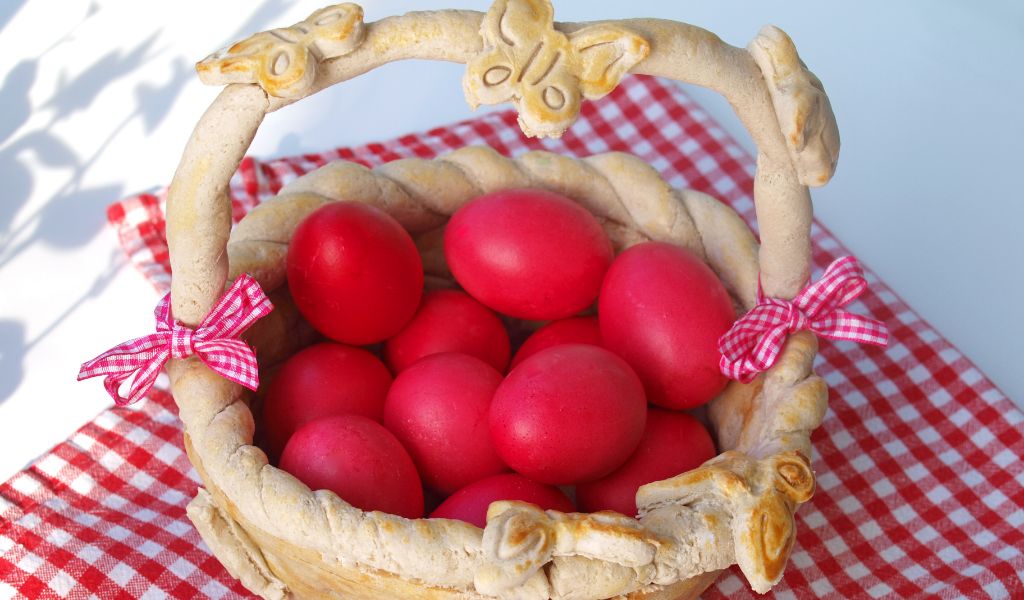
Another cherished custom that brings life to Greek Easter in Mykonos is the game of cracking red eggs. This practice, which bridges generations, is imbued with deep symbolism. The red eggs represent the sealed tomb of Jesus and the promise of new life, with the act of cracking them open symbolizing Christ’s resurrection. The playful competition to find the last unbroken egg adds a layer of communal joy to the Easter celebrations, connecting everyone in a shared moment of fun and reflection.
The Path to Greek Easter in Mykonos: A Sacred Journey
The Spiritual Prelude: From Clean Monday to Easter
The journey towards Greek Easter in Mykonos begins 40 days prior to Easter Sunday, starting with a symbolic procession from the Panagia Tourliani Monastery in Ano Mera. This procession, a profound demonstration of faith and tradition, sees priests and pilgrims alike traversing 8km to Chora, marking the commencement of a period steeped in devotion and anticipation. The icon’s display in the Church of Life Giving Spring becomes a focal point for the island’s spiritual life, underscored by the presence of children with palm leaf wreaths, embodying hope and renewal.
Culinary Symbols of Faith: Lazarakia and Lambrokouloures
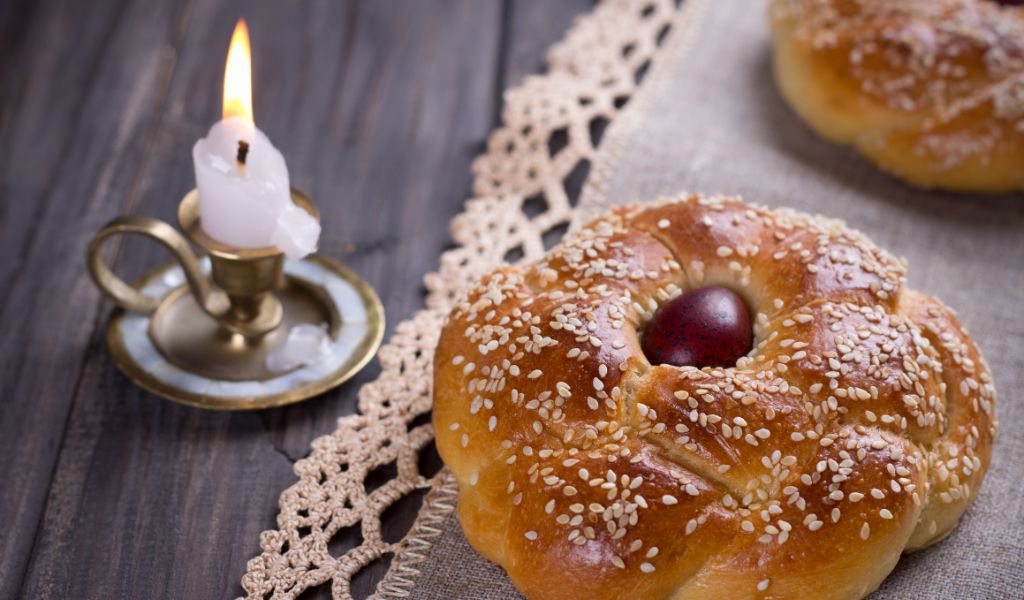
The preparation of ‘Lazarakia*’ and ‘lambrokouloures*’ in the weeks leading up to Easter showcases Mykonos’s rich culinary traditions intertwined with religious observances. These delicacies, each bearing deep symbolic meanings — from the resurrection of Saint Lazarus to the Holy Trinity – underscore the integral role of food in Greek celebrations. The meticulous preparation and specific ingredients of these breads reflect the island’s adherence to Lenten customs, blending spirituality with gastronomy.
* Lazarakia
Lazarakia is a sweet, spicy bread made with currants and shaped like a little man with his arms crossed over his chest, resembling a shroud. This bread, which features cloves for eyes, represents Saint Lazarus of Bethany, whom, according to Christian tradition, Jesus Christ raised from the dead. The making of Lazarakia is a custom observed on Lazarus Saturday, the day before Palm Sunday, and this bread is made without dairy products, adhering to the Lenten fasting rules which exclude dairy. The symbolism of Lazarakia ties directly to the themes of resurrection and life, central to the Easter celebrations.
* Lambrokouloures
Lambrokouloures is another type of sweet bread that is traditionally prepared during the Easter period. This bread is characterized by its braided form, which symbolizes the Holy Trinity, and is often decorated with special red eggs. The preparation of lambrokouloures, like Lazarakia, is deeply embedded in the religious and cultural practices of Easter, reflecting the thematic elements of rebirth, spirituality, and the continuation of life. Its intricate design and the inclusion of red eggs further imbue it with layers of meaning, particularly reflecting on Christ’s resurrection and the promise of eternal life.
Reflection and Resurrection: The Emotional Spectrum of Holy Week
Good Friday in Mykonos presents a somber contrast to the island’s usual vibrancy, with gospel lamentations and the solemn procession of the casket through the villages. This day of mourning vividly captures the communal empathy for the sorrows of the Virgin Mary. The transition into Holy Saturday evening’s luminous celebration of resurrection, with the sharing of the Holy Light and the joyful proclamation of “Christos Anesti,” marks a poignant shift from sorrow to jubilation.
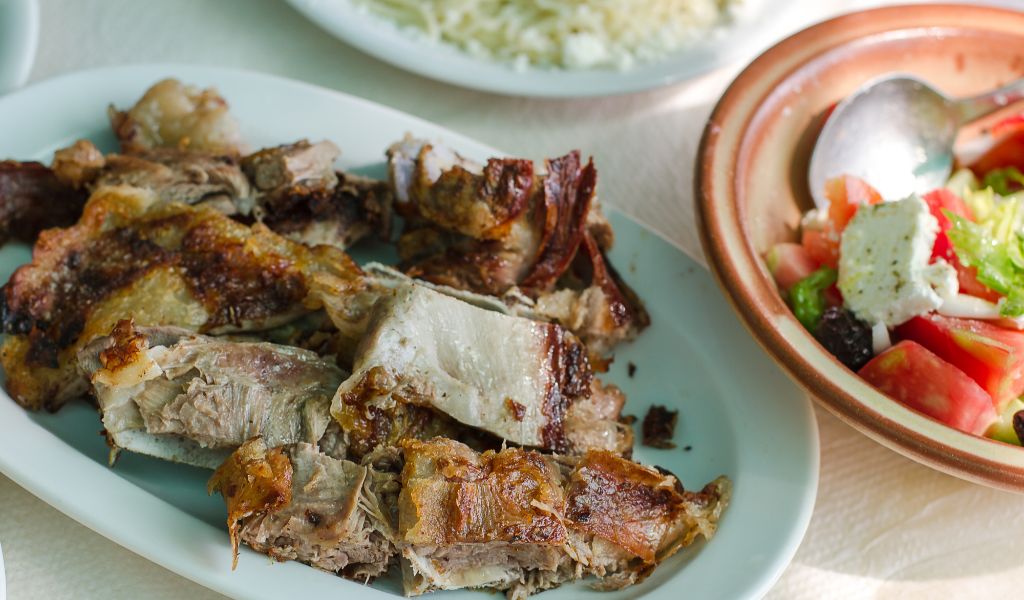
Embracing Greek Easter in Mykonos
Greek Easter in Mykonos culminates in a grand spectacle of hospitality, warmth, and communal joy. Easter Sunday is not merely a day but a manifestation of Greek ethos — from the lamb roasted on the spit to the crack of red eggs, each tradition enriches the fabric of Mykonos island Greece. This day of feasting, shared among returning family members and friends, highlights the unparalleled Greek hospitality and the vibrant local culture.
The entire Easter period in Mykonos, from the preparatory rites of Clean Monday to the jubilant gatherings of Easter Sunday, offers a glimpse into the soul of the island. It is a time when the sacred and the communal merge, when ancient traditions are lived with fervor, and when every visitor is welcomed to partake in the celebration of life, renewal, and togetherness.
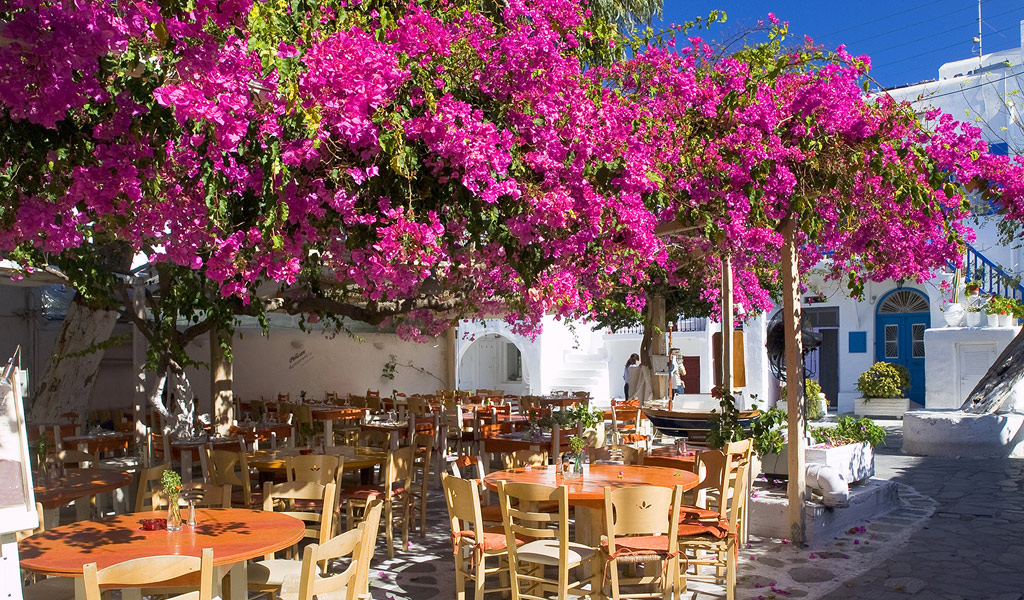
Experiencing Greek Easter in Mykonos is to witness the island at its most authentic, a time when the spirit of community, faith, and festivity envelops every corner. It’s an invitation to immerse oneself in a celebration that transcends the mere observance of religious rites, becoming a journey into the heart of Greek culture and Mykonian hospitality.
Read Also:
- Experience the Best Beaches in Mykonos: A Connoisseur’s Guide
- Find Your Perfect Accommodation: Where to Stay in Mykonos
- Unlock the Magic of Mykonos on a Budget
- Unveiling the Top Beachfront Hotels in Mykonos for an Unforgettable Stay
- Mykonos Travel Guide: Experiencing the Island’s Dual Charm
- Travelling to Mykonos: A Comprehensive Guide
- All Inclusive Hotels in Mykonos Greece

